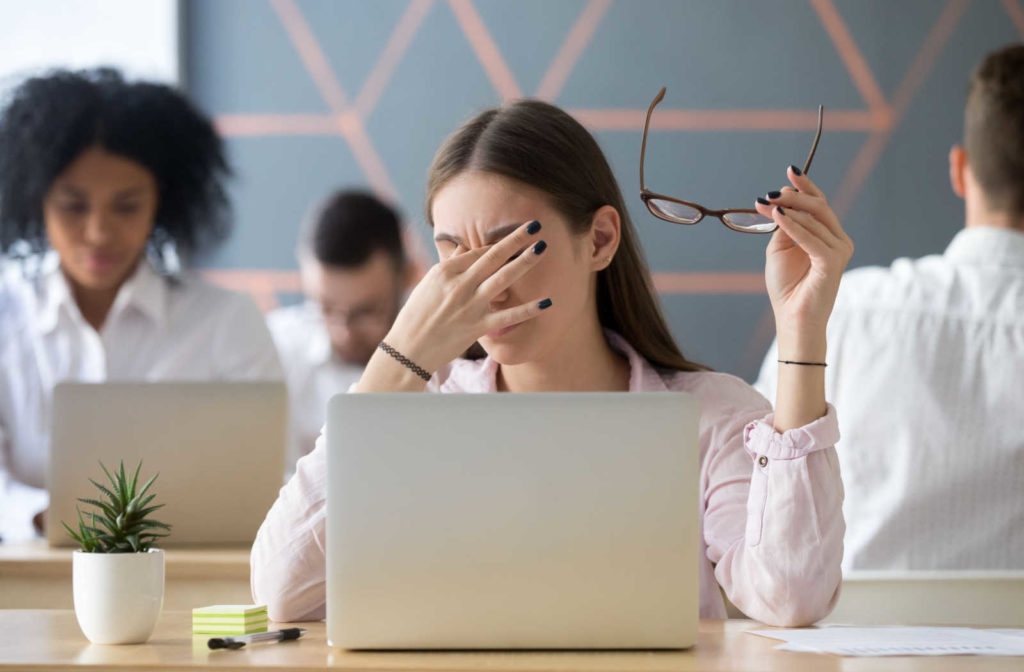Are you one of the millions of people spending hours in front of a screen each day? Maybe it’s for work, scrolling through social media, or binging your favourite shows. As much as we rely on screens for our daily lives, many don’t realize the strain it can have on our eyes. That strain is known as digital eye strain or computer vision syndrome.
The best way to prevent digital eye strain is to take regular breaks from the screen. Make sure to give your eyes a break and look away from the computer at least every 20 minutes. Adjusting your monitor settings can also help reduce eye strain.
Digital eye strain can occur when we spend prolonged periods looking at screens. It can cause eye discomfort, dryness, blurry vision, headaches, and neck and shoulder pain.
It’s crucial to take steps to prevent digital eye strain, not only for our short-term comfort but also for the long-term health of our eyes.
Symptoms of Digital Eye Strain
Digital eye strain can manifest itself in several ways. Some of the most common symptoms are:
Eye fatigue: This is perhaps the most typical symptom of digital eye strain. Your eyes may feel tired, heavy, and in some cases, sore. Eye fatigue can also lead to difficulty focusing.
Dry eyes: When we look at screens, we have a reduced blinking rate, which can cause dry eyes. You may feel like you need to rub your eyes frequently or may experience dry or burning sensations.
Blurred vision: Prolonged screen time can make it challenging to focus. You may notice blurred vision, particularly when looking away from digital screens.
Headaches: If you’re experiencing digital eye strain, you may encounter regular headaches, particularly around the temples or behind the eyes.
Neck and shoulder pain: Poor posture coupled with screen time could result in neck and shoulder pain. This could be caused either by leaning forward to read your screen or holding your phone at an awkward angle.
Eye Strain Prevention Tips
Digital eye strain is a growing concern, but the good news is that there are several ways to prevent it. Here are seven tips for reducing the risk of digital eye strain:
- Adjusting screen settings: One of the most effective ways to prevent digital eye strain is to adjust your screen settings. The brightness and contrast levels should be balanced so that the screen does not strain your eyes. Additionally, you can increase the font size to reduce eye strain.
- Using blue light filters: Blue light filter technology has been gaining popularity. These filters limit the amount of blue light emitted from screens, which may cause eye discomfort. You can get special glasses with blue light filters or adjust your screen settings to decrease blue light.
- Reducing glare: Glare is another common cause of digital eye strain. You can reduce glare by positioning your screen away from windows and direct light sources. Anti-glare screens or covers for your devices can also reduce the amount of glare.
- Proper lighting: Proper lighting is crucial for preventing digital eye strain. Lighting should be bright enough to see your screen, but not too bright that it causes discomfort. Avoid excessively bright light or harsh fluorescent lights, which can make your eyes feel tired or strained.
- Regular eye breaks: Taking regular eye breaks can help prevent digital eye strain. Every 20–30 minutes of screen time, take a break for at least 20 seconds to focus on an object in the distance. This can help to relax the focusing muscles in your eyes and reduce fatigue.
- Blinking exercises: Blinking exercises can also help reduce digital eye strain. Regular blinking helps to keep your eyes moist, which reduces strain. To exercise your blinking, try blinking every time you complete a task, such as responding to an email.
- Eye-friendly diet: A healthy diet full of vitamins and minerals can also contribute to the prevention of digital eye strain. Foods that are rich in omega-3 fatty acids and antioxidants, such as leafy greens, citrus fruits, and fish, provide important nutrients for eye health. Drinking enough water regularly can also help to keep your eyes moist and comfortable.

When to Seek Professional Help
When it comes to eye strain, prevention is truly the best medicine. But, even with the best prevention in place, there may come a time when you need to seek professional help. Here are a few things to keep in mind.
First, recognize the signs of severe eye strain. Symptoms like blurred vision, headaches, neck or shoulder pain, and even dizziness or nausea may all be signs that you are experiencing something more than just mild eye strain.
If you are experiencing these symptoms, it’s time to see an optometrist. Your optometrist can perform a thorough eye exam, looking for underlying conditions that may be contributing to your eye strain. They can also give you tips and recommendations for managing your symptoms and preventing further eye strain.
Some treatment options your optometrist may recommend include eye drops to help relieve dryness or fatigue, corrective lenses or glasses to improve your vision and reduce strain, and lifestyle changes like taking regular breaks from screens or adjusting your work environment to be more eye-friendly.
Your Partners in Eye Health
Of course, we hope you never get to the point where you need to seek professional help for severe eye strain. The best course of action is always prevention. But, if you do find yourself struggling, know that there is help available. Don’t hesitate to reach out to our team for guidance, support, and treatment options.
At Calgary Optometry Centre, we believe that taking care of your eyes should be a top priority. By incorporating these preventive measures and seeking professional help when needed, we can all work towards maintaining healthy eyes for years to come.




